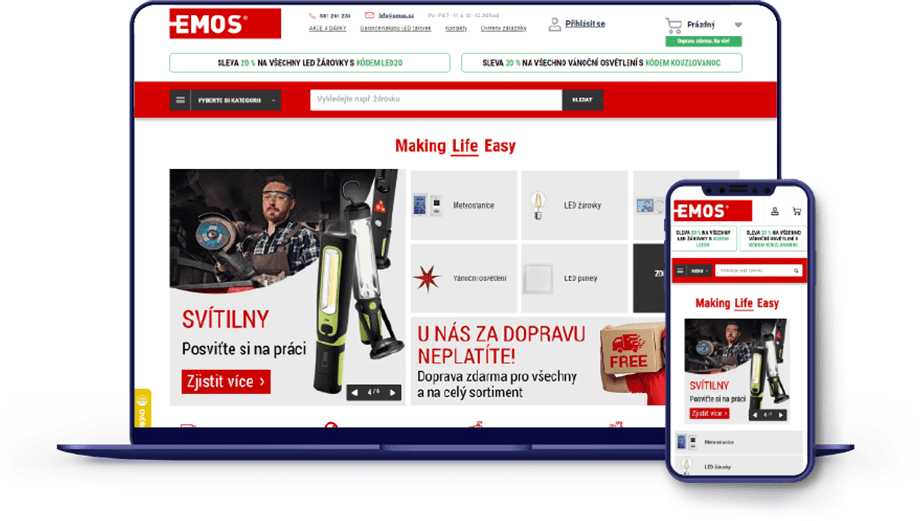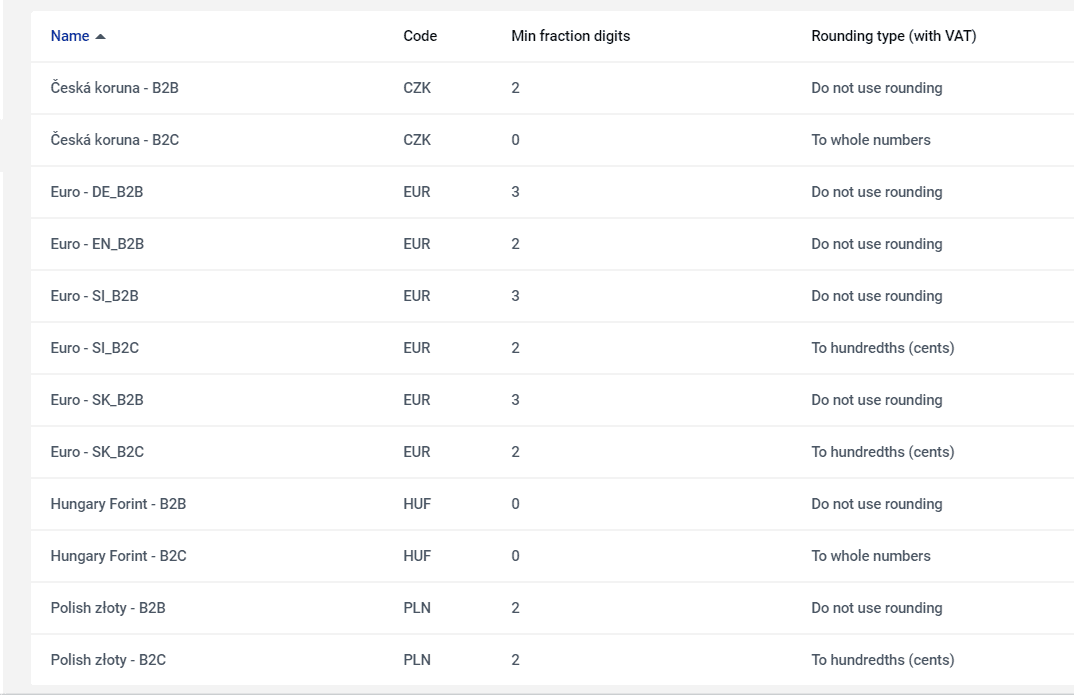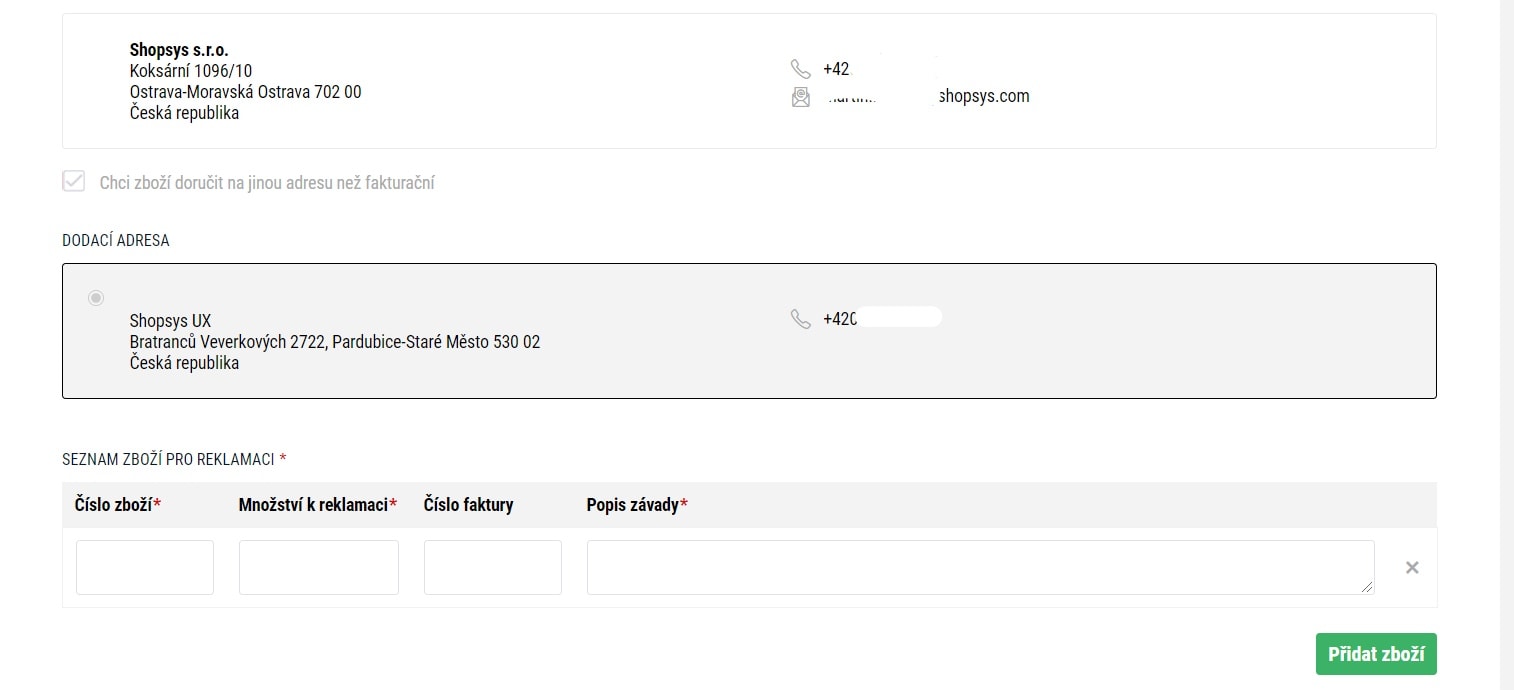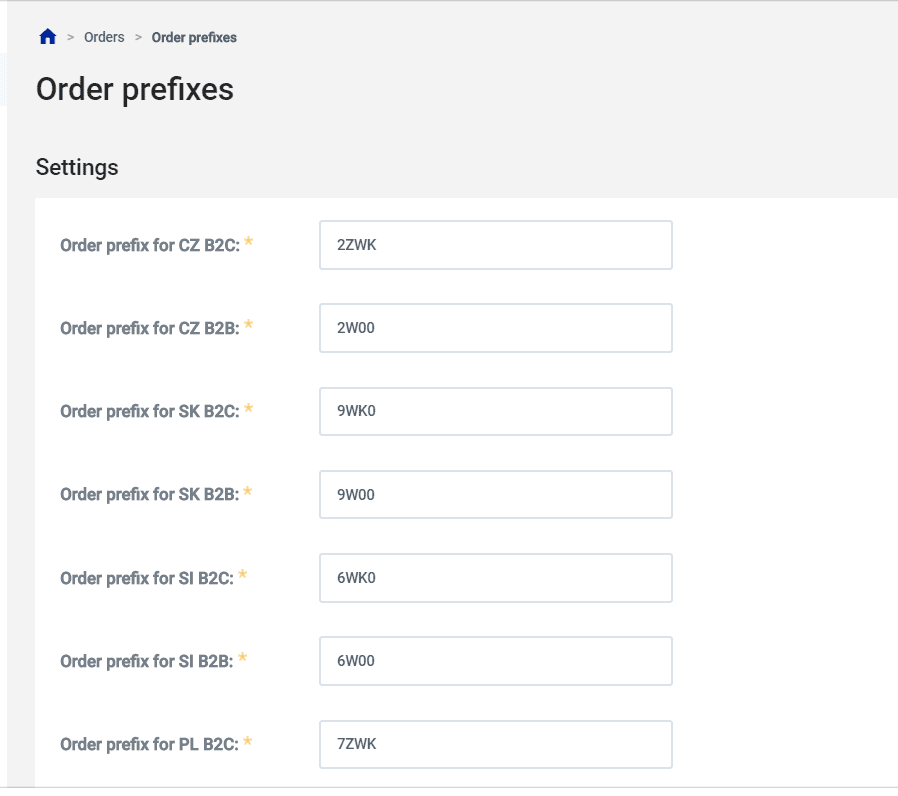We take pride in finding ways to adapt ecommerce projects to the specifics of their industry. In the case of EMOS, our challenge was to prepare twelve B2B and B2C domains in seven languages in a short amount of time so that we could release it before the main season and the expiration of the license from its previous provider. Early results have already indicated a 40% increase in EMOS’ conversion rate and a 9% increase in the average value of orders.

EMOS – International distributor of small electricity
Emos spol. s r. o. is a long-term international distributor of small electrical goods under its own brand EMOS. With its branches in Poland, Slovenia, Slovakia and Hungary, it supplies its products through a network of distributors to 26 European countries. It is the exclusive supplier of GP Batteries and GP Powerbank products in several European countries, including the Czech Republic. Today, it has more than 2,500 items in its product portfolio. In addition, it operates its own eshop with a showroom in Přerov. This Czech company was founded in 1991, has undergone a dynamic development since then and currently employs over 300 employees.
95% of EMOS’ turnover is provided by B2B sales (B2B portal, sales representatives). EMOS B2B eshop is far from just a shopping environment. It also serves as a portal for document workflow management (enabling, for example, confirmation of credit notes), complaints and other related functions.
EMOS also expands into B2C sales, which is growing dynamically in this segment. In the future, EMOS wants to focus more on B2C sales and selling directly to end consumers.
Why did EMOS decide to change supplier?
The original eshops (7 B2B portals, 5 B2C eshops) that ran on the Kentico platform, after several years of development, showed technological debt and often generated errors. In addition, each online store had its own administration panel. This was a problem for centrally managed eshops for the global administrator, as they had to constantly switch between versions. EMOS was not satisfied with waterfall form of development from their former platform supplier with frequent black boxes, late completion of tasks and their unusability without further modifications, insufficient communication and low degree of flexibility. It all resulted in a loss of trust. Another disadvantage of the original platform was the difficult-to-implement customization.
In the fall of 2019, with the impending expiration of the license, EMOS decided it was time to change suppliers. EMOS’ ecommerce manager, Mr. Jan Havelka, created an overview of available ecommerce platforms and solutions that would suit the company – a platform capable of providing the necessary B2B and B2C ecommerce functionality. The condition was also the Czech based solution. Of the 17 possible variants, only 2 platforms remained – Magento and Shopsys Framework, which were able to provide sufficient capacity and a quality product. Before making the decision, Mr. Havelka called our references to OFFICE DEPOT s.r.o., B2B Partner s.r.o., Pavlík Stationery, Démos and Agátin svět. After excellent responses from our clients, we started work on their solution.
How the process of development looked like
Pre-implementation phase
At the first meetings, an analysis of the weak points of the current solution was carried out and the vision of the new project was outlined. The result was a list of functionalities that EMOS wanted to include. Our UX experts focused on the most common problems that EMOS customers encounter.
Then, the list of new platforms’ functionalities were prioritized according to their importance in releasing the first version of the project, deadline, and costs.
To verify that the newly required features make sense, a UX workshop was carried out with EMOS employees from various departments across the company. The view of people who are in daily contact with customers was, as expected, different from the view of management. Therefore, it was necessary to design a solution that will meet business goals, but also facilitate the work of people in EMOS. The output of the workshop was a prototype of the website, thanks to which it was possible to start writing user stories and at the same time prepare a new shop design.
How the development and implementation took place
The development took place on the open source platform Shopsys Framework v9.0.0 beta, agile in 14 daily sprints. A team of 15 people from Shopsys took part in the project, including the complete Shopsys Framework team. On behalf of EMOS, Jan Havelka, an ecommerce specialist, was responsible for leading the project. Even before the launch of the new platforms, the Shopsys Framework platform was upgraded to the stable version 9.0.1., so in the released version projects ran to the latest and safest version of the platform.
The first three domains of B2C online stores were launched according to the planned schedule on June 29, 2020. The B2B portals were launched on August 21, 2020.
Customized features
This project stands out by a number of customized B2B features, which aim to improve the user experience and minimize the work required for B2B customers.
Customization had to take into account the different needs and shopping behavior in individual countries for which EMOS has its own language versions (eg. Hungary, Poland), but also meet the requirements of the English and German versions of the eshop for customers from the Balkans, Baltics, and Eastern Europe.
Features common to B2B and B2C
- Current stocks by domain – each of the domains has its own warehouse in administration (for B2B and B2C).
- Progressive Web Application (PWA) – technology that allows EMOS customers to experience a native-app-like experience within their platforms. The EMOS project is ready to launch PWA, which is planned for the future.
- Download Center – product cards contain links to the latest versions of manuals, declarations of conformity, software updates, as well as downloadable ringtones, etc.
- Product technician – each product has its guarantor-expert, to whom the customer (B2B and B2C) can turn for help.
- The view of different parameters when comparing products – the customer clearly sees how the individual products differ and thanks to that he can make a wise decision.
- Customizing the view of currencies on different domains – the view of currency (number of decimal numbers) on each of the domains can be customized to the customer’s needs. In this case, for example, in B2B domains the EUR is rounded to 3 decimal places, in B2C domains only to 2 decimal places and in the Hungarian domain the prices are in HUF without decimal places.

Features for B2B
- Unified administration of all e-shops in English – enables administration across all foreign domains and facilitates control of the platform in an international environment (B2B – cz, sk, si, pl, hu, de, en, B2C – cz, sk, si, pl, hu).
- An open access to B2B portal – it allows to attract new customers.
- Sales representatives – in the administration panel each sales representative sees all their customers, they can log in as a customer and manage their orders (make orders, complete purchases, etc.), each B2B customer has in the online store a direct contact with the sales representative.
- Individual price lists – each logged in user can have their own prices, which may vary within one company.
- Each customer has its own free shipping threshold, invoice payment date.
- Import of order from file (TXT, Excel).
- Dynamic XML feeds – selected customers have 3 feeds available (main, available, price), thanks to which they can, for example, easily link their system with information from the eshop.
- Purchases over stock with B2B users.
- Complaints – a B2B customer can claim goods from several orders at once within a single complaint.
- Custom order prefix – you can create a 4-digit prefix followed by a number series, which the customer can define so that it almost follows the orders from the original e-shop. (e.g. the number of the last order in the original shop 2ZWK001853, the number of the first order in the new e-shop 2ZWK002000).


Features for B2C
- Disabling filtering – for categories where there are multiple products with different parameter sets, the parameter filter can be completely disabled. This leaves only a price and flag filter, and the customer is directed to choosing a more accurate category to find faster what they are looking for.
- Logical ordering of parameters for individual product categories – eg. for light bulbs parameters such as socket, luminosity are more important than for digital scales.
Effectiveness of new solutions
From the data we quickly noticed that shortly after the launch the new eshops were doing very well. This is despite the fact that there was a transition to another URL, which slowed down some of the effects. EMOS’ turnover (also due to the covid lockdown) increased to 167% year-on-year. For B2C portals, the conversion rate increased by 33.3% on mobile devices, and even by 40% on the desktop. The number of executed transactions increased by 6%. Currently, the conversion ratio for B2C CZ is over 2% and the number of completed orders is still growing. The average value of the order also increased, by 9% (5.9% on mobile devices, 9% on the desktop).
Due to the fact that B2B portals were launched shortly before the creation of this case study, we cannot yet provide relevant data reflecting their performance. We will monitor the data in the coming months and update the case study in the first months of next year.

JanHavelka
From the first meetings, Shopsys kept convincing us of high professionalism. Whether you talked to a project manager, programmer, coder, or UX designer, it was always a knowledgeable person who first listened to the nature of the problem or requirement and then proactively designed with colleagues a solution that delivered the required value with the least cost of time. I consider this approach to be one of the biggest benefits of working with Shopsys.
For a period of ten months of intensive cooperation on the project, not only the above, but also the deadline for putting the eshops into operation and compliance with the agreed budget further confirms my sense of the right choice of implementer.


